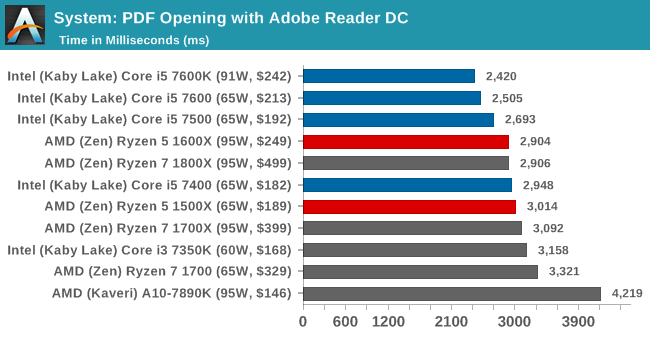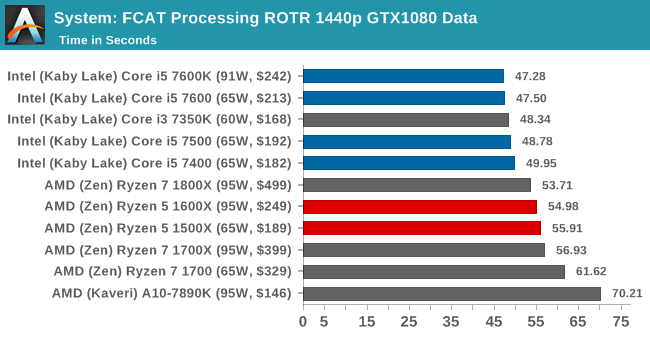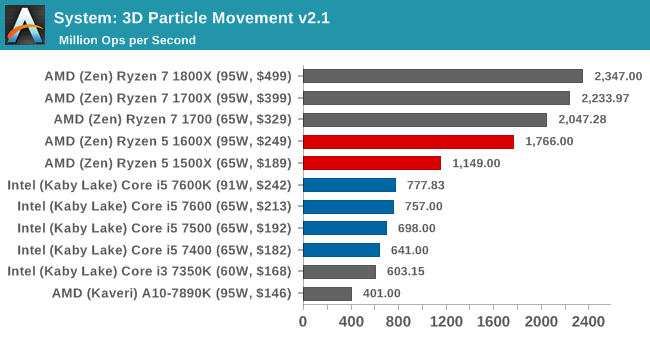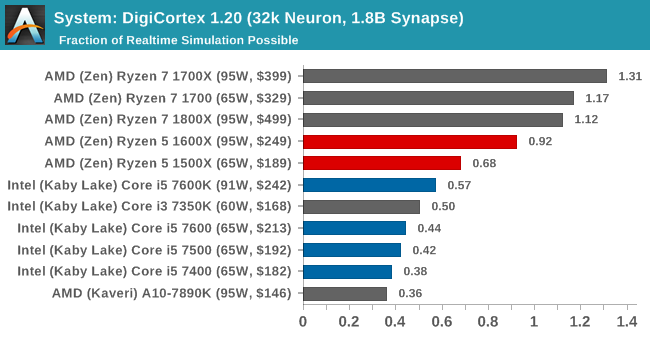The AMD Ryzen 5 1600X vs Core i5 Review: Twelve Threads vs Four at $250
by Ian Cutress on April 11, 2017 9:00 AM ESTBenchmarking Performance: CPU System Tests
Our first set of tests is our general system tests. These set of tests are meant to emulate more about what people usually do on a system, like opening large files or processing small stacks of data. This is a bit different to our office testing, which uses more industry standard benchmarks, and a few of the benchmarks here are relatively new and different.
PDF Opening
First up is a self-penned test using a monstrous PDF we once received in advance of attending an event. While the PDF was only a single page, it had so many high-quality layers embedded it was taking north of 15 seconds to open and to gain control on the mid-range notebook I was using at the time. This put it as a great candidate for our 'let's open an obnoxious PDF' test. Here we use Adobe Reader DC, and disable all the update functionality within. The benchmark sets the screen to 1080p, opens the PDF to in fit-to-screen mode, and measures the time from sending the command to open the PDF until it is fully displayed and the user can take control of the software again. The test is repeated ten times, and the average time taken. Results are in milliseconds.

Opening PDFs using Adobe is significantly single threaded, hence why Intel takes the win here for the most part - the 7400 is slightly lower on frequency, enough for the 4.0 GHz Ryzen parts to push ahead.
FCAT Processing
One of the more interesting workloads that has crossed our desks in recent quarters is FCAT - the tool we use to measure stuttering in gaming due to dropped or runt frames. The FCAT process requires enabling a color-based overlay onto a game, recording the gameplay, and then parsing the video file through the analysis software. The software is mostly single-threaded, however because the video is basically in a raw format, the file size is large and requires moving a lot of data around. For our test, we take a 90-second clip of the Rise of the Tomb Raider benchmark running on a GTX 980 Ti at 1440p, which comes in around 21 GB, and measure the time it takes to process through the visual analysis tool.
Similarly, FCAT is single threaded as it analyzes frame-by-frame. The extra frequency helps Intel here.
3D Particle Movement v2.1
This is the latest version of the self-penned 3DPM benchmark. The goal of 3DPM is to simulate semi-optimized scientific algorithms taken directly from my doctorate thesis. Version 2.1 improves over 2.0 by passing the main particle structs by reference rather than by value, and decreasing the amount of double->float->double recasts the compiler was adding in. It affords a ~25% speed-up over v2.0, which means new data.
DigiCortex 1.20
Despite being a couple of years old, the DigiCortex software is a pet project for the visualization of neuron and synapse activity in the brain. The software comes with a variety of benchmark modes, and we take the small benchmark which runs a 32k neuron/1.8B synapse simulation. The results on the output are given as a fraction of whether the system can simulate in real-time, so anything above a value of one is suitable for real-time work. The benchmark offers a 'no firing synapse' mode, which in essence detects DRAM and bus speed, however we take the firing mode which adds CPU work with every firing.
Agisoft Photoscan 1.0
Photoscan stays in our benchmark suite from the previous version, however now we are running on Windows 10 so features such as Speed Shift on the latest processors come into play. The concept of Photoscan is translating many 2D images into a 3D model - so the more detailed the images, and the more you have, the better the model. The algorithm has four stages, some single threaded and some multi-threaded, along with some cache/memory dependency in there as well. For some of the more variable threaded workload, features such as Speed Shift and XFR will be able to take advantage of CPU stalls or downtime, giving sizeable speedups on newer microarchitectures.

Because parts of Photoscan are very multithreaded, such as the first stage, there's plenty of scope for the Ryzen CPUs to pull ahead here.













254 Comments
View All Comments
vladx - Thursday, April 13, 2017 - link
Yes as someone with both a 7700k system and a 1700X system I can safely call myself unbiased as I hold no special loyalty towards any brand.Cooe - Monday, March 1, 2021 - link
Liar liar, pants on fire lol.cryosx - Thursday, April 13, 2017 - link
they were testing against the direct competition (i5s) and the rest of the ryzen family. Makes sense, though I guess having the i7s in would be a nice touch.Nightsd01 - Wednesday, April 12, 2017 - link
"[Ryzen] has 50% more cores and 200% more threads"Wouldn't it be 300% more threads? 12 threads is 3x more than 4
Outlander_04 - Thursday, April 13, 2017 - link
200% MOREcvearl - Thursday, April 13, 2017 - link
Curious what method on GTAV was used. I get in the 70's at those settings on my RX480 all VH settings on an i7 2600k.ianmills - Thursday, April 13, 2017 - link
Dolphin benchmarks still missing!Notmyusualid - Tuesday, April 18, 2017 - link
@ianmillsI was looking for them too.
msroadkill612 - Thursday, April 13, 2017 - link
Ryzens tough for cheapskates. its a nice cheap 4 core, but gee, for so little more u get a 6 core 1600.msroadkill612 - Thursday, April 13, 2017 - link
zen is just amds first act.The second is naples - gluing multiple ryzens together using their excellent new plumbing.
The third is vega (gpu has long been amdS focus - in a10apuS e.g.).
The last and seismic act, is a ccx with a single zen core block of four cores & same 4mb l3 cache, and a vega gpu, possibly with hbm2 vram.
Its not very new ground for them. its very similar to the architecture solutions needed for the a10.
Incidentally, i heard a great debate about "dark coding?".
coders love using the gpu for compute when they can, cos it shifts heat away from stressed processors. cooler processors can then run faster. IE, they try and shift the load around the circuitry to avoid generating hot spots.
The conclusion omitted to say "if u consider pc software static.... Then buy intel"
new generation and paradigm, or the last tart up of the old generation. Your choice.
There are of course wins and losses by both, but we know that we are measuring the best of the old, with the lowest point of the rapidly improving new. (see ashes of singularitytweak)
& as above, its just act 1 now.
The authors haughty dismissal of amdS top am4 chipset features is outrageously deceptive (as said in posts here).